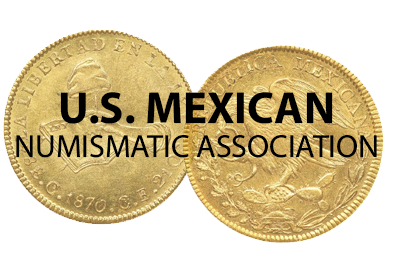Pre-Columbian Series – Olmec Collection – Silver 1 Oz. (Uncirculated & Proof)
by Alberto Rodriguez
Introduction
The fourth installment of this multi-part series, on the Pre-Columbian series for 1 ounce silver coins, will cover the Olmec collection. If you missed the first three articles from the previous three editions of this journal, I encourage you to read those first, where a more thorough introduction was presented. The purpose of these articles is two-fold. First, these articles look to share the storytelling of this series first introduced to me by the late Don Bailey’s Whitman Encyclopedia of Mexican Money Volume 2. In addition, these articles seek to provide clarity into the multiple varieties of the coins in the series and distill the ambiguity that exists surrounding mintages for this series.
This series of articles has thus far detailed simple collections like the Mayan, where a single variety of each coin design was released for each finish, uncirculated and proof. Conversely, the Aztec collection not only had multiple varieties for each finish, but they were minted in multiple years due to the impact of the Coinage Reform of 1992. The Olmec collection reintroduces this latter complexity with design releases in both 1996 and 1998 for the uncirculated finish.
Before we begin, it is once again worth highlighting two factors that have obscured collectors’ understanding of mintages for this particular series. As highlighted in earlier articles, both online coin directories and authoritative catalogs only publish the original mintages from when the coins were first released, but leave out officially published restrikes, by the Banco de México. The Pre-Columbian series, in fact, minted additional strikes from the years 2000 – 2011.
Another factor to take into consideration is what I have termed the Melted Factor. Anecdotally several folks in the business, both in Mexico and the United States, have suggested that during the parabolic silver price run up of 2010- 2011, 35%-50% of silver Pre Columbians had been melted. Further evidence from Mexican coin collectors and old online message board posts suggests this series was long treated like bullion and has long sold for spot. Many of the surviving pieces also have evidence of acid tests on the surface. Taking this Melted Factor into consideration provides a more accurate representation of available mintage today. Since the publication of the first couple articles, it has been brought to my attention by readers of this journal, that proof coins have always commanded a market premium versus their Brilliant Uncirculated counterparts and as such, the Melted Factor on Proofs is likely to be close to the lower bound of 35%, whereas the Brilliant Uncirculated are likelier to converge to the 50% estimate. Additionally, collectors are finding it much harder to find high grade uncirculated versions of the coins versus their Proof counterparts.
The Olmec Collection
The introductory aspect of each collection’s cultural history in these articles has not been a fresh curation of historical highlights and facts. Actually, these sections of the articles have been direct passages, with some grammatical changes, from the late Don Bailey’s Whitman Encyclopedia of Mexican Money Volume 2. In article three, I shared my excitement regarding Whitman’s revitalization of the book when it started to revive publication of the book. Before the summer of 2024, it was increasingly difficult to secure a book on the open market without paying a very significant markup. If you do not already own the book, I hope these articles will deliver the same excitement I experienced when I first started reading Don’s stories and drive you to buy yourself a copy. Now back to our feature presentation.
The fourth collection in the program honors the Olmec culture, which flourished in central Mexico and parts of Guatemala, Honduras, and Costa Rica around 1200 to 400 BC. The Olmec archaeological sites of San Lorenzo, La Venta, and Tres Zapotes are located in the tropical lowlands close to the Gulf of Mexico, in what are now the states of Veracruz and Tabasco.
The Olmecs created monumental basalt sculptures of heads, human figures, thrones, and supernatural creatures. The best known of these are called the Colossal Heads, which are believed to have represented individual rulers. Ranging in height from 5 to 11 feet, the Colossal Heads have been found in several of the Olmec cities with those found at San Lorenzo being the oldest. The basalt from which the sculptures were carved was brought down from the mountains some 60 miles to their final destinations in the lowlands.
Olmec society was hierarchical, with wealth and status determining social class. The higher class of rulers, priests, and skilled artisans lived in the cities. The lower class farmed the surrounding rural areas, producing cotton, maize, and squash. Through trade, they gained access to luxury items, including the precious jade from which they created jewelry, figurines, and various items for religious rituals. Mirrors of polished iron-ore have also been discovered as seen in Olmec art. They were worn on the chests of the elite, including the priests, suggesting that mirrors may also have been used in rituals. Much speculation surrounds the Olmecs, but their artifacts suggest they were the first Mesoamerican culture to practice bloodletting, and that they created the Mesoamerican ballgame and invented the calendar that would later inspire the Mayan calendar. The decline of the Olmec civilization came long before the Spanish arrived. The exact cause is unknown. Archaeologists have suggested that a volcanic eruption may have forced their dispersal or that climate change may have devastated their crops. San Lorenzo was the first city to fall into decline, leading to the prominence of La Venta. When La Venta in turn declined and was abandoned, Tres Zapotes, located in what is now the Veracruz region, became the center of Olmec culture. The Olmec evolved into what is known as the Epi-Olmec culture, which gave rise to the Central Veracruz culture and the city of El Tajín. It was not until the 1850s that what remains of the Olmec culture was discovered by Europeans.
Señor de Las Limas
Señor de las Limas (Master of the Limes) is the central motif on this coin design. It is modeled after the original Señor de las Limas, a greenstone sculpture of a seated priest with a baby jaguar-human in his arms. It was found in the Valley of the Limes in the region of Veracruz and is held in the collection of the Museum of Anthropology in Xalapa. According to archaeologists, the sculpture is related to fertility and maternity rituals. The coin’s border design is inspired by a pre-Columbian symbol for “fire.” The silver 1oz coins in this design were issued in 1996 in both Brilliant Uncirculated and Proof, in 5 pesos denomination. This coin was issued again in 1998 in Brilliant Uncirculated only.
Señor de las Limas – Brilliant Uncirculated (BU) Variety Overview
The Brilliant Uncirculated coin has a reverse with a Master of the Limes figure at the center of the field with the date to the left, the mintmark to the right (MMR), and SEÑOR DE LAS LIMAS in the exergue below. An ornamental border surrounds the square field whose perimeter is defined with convex sides, with N$5 below. The design of the 1996 and 1998 editions is identical, only distinguished by the year.
The obverse of the coin displays the national coat of arms with the eagle facing left with its feathers resembling plates of armor on the center of a square field with convex sides. Above it, the legend ESTADOS UNIDOS MEXICANOS, and below it, a half-wreath of oak and laurel. Surrounding the field is an ornamental border. Below the border is displayed 1 ONZA DE PLATA, and further below LEY 0.999
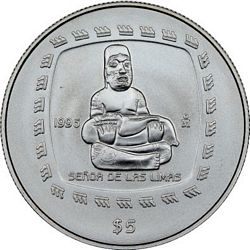
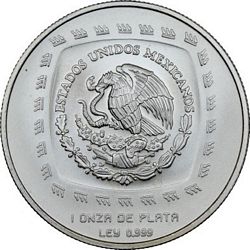
Señor de las Limas 1996
$5 New Pesos (MMR) Raised Denomination
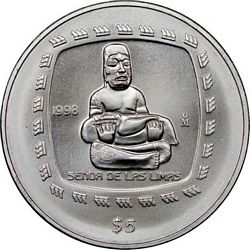
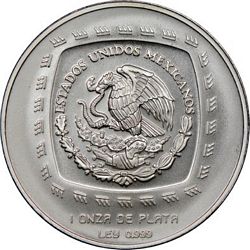
Señor de las Limas 1998
$5 New Pesos (MMR) Raised Denomination
There were 9,200 original strikes for the 1996 issue of the 1oz silver Señor de las Limas coin. The three primary sources referenced in all these journal articles, The Standard Catalog of World Coins, Whitman Encyclopedia of Mexican Money, and Numista agree on the original mintage for this coin.
References for the 1998 edition of this coin, however, suggest 4,700 original strikes were issued according to the Whitman Encyclopedia of Mexican Money, while the Standard Catalog of World Coins and Numista both indicate only 3,400 original strikes. As mentioned in earlier articles, this conflicting compilation of figures makes it a slightly cumbersome task to reconcile original mintage figures. Banco de México currently has published mintage numbers on their website only for the year 2000 and onward, lacking any line of sight into mintage beforehand. I have not explicitly stated this before, but those who worked closely with the late Don Bailey indicated that he had very close relationships with the mint and others within the Mexican numismatic world. Therefore, I have always settled on his figures for reconciling original mintage strike totals.
The additional strikes from the years 2000 – 2011 are published on the Banco de México’s website but lack distinction between varieties or years for a given coin. The additional strikes total 1,900. We have no way of deterministically reconciling how many were 1996 and 1998. We will distribute this total between the 1996 and 1998 varieties by applying the ratio of 1996 vs. 1998 for Bailey’s original mintage statistics. Using this methodology, the resulting additional strikes in subsequent years, per 1996 and 1998 variety, are 1,257 and 643 respectively.
It is worth noting that the 1998 Brilliant Uncirculated varietals of this series are increasingly difficult to find, and in particular in high grade. Furthermore, fellow collectors and I myself find these specific coins are quite often found for sale in cleaned condition.
With the additional strike figures detailed above, the grand total combined per 1996 and 1998 variety is 10,457 and 5,343 respectively.
Applying the Melted Factor, discussed in the introduction (35-50%) leaves us with an estimated survival mintage of 5,229 – 6,797 for the 1996 variety and 2,672 – 3,473 for the 1998 variety. Collating all the aforementioned figures results in the following table:
| 1oz Silver MS Pre-Columbian Series - Señor de las Limas | |||||
| Original Mintage | Restrikes | Total Including Restrikes | Estimated Minimum Surviving | Estimated Maximum Surviving | |
| 1996 5 Pesos MMR | 9,200 | 1,257 | 10,457 | 5,229 | 6,797 |
| 1998 5 Pesos MMR | 4,700 | 643 | 5,343 | 2,672 | 3,473 |
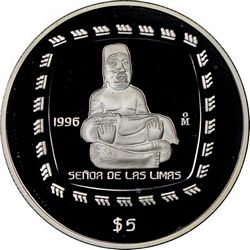
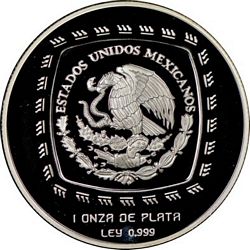
Señor de las Limas 1996
$5 New Pesos (MMR) Raised Denomination Proof
Señor de las Limas – Proof Variety Overview
The 1oz Señor de las Limas silver Proof shares the same coin elements as its Brilliant Uncirculated counterpart but is further distinguished by a mirrored inner field and border area on both sides with a raised and frosted denomination on the reverse as well as a raised and frosted legend on the obverse. Oddly only a 1996 variety was released for the proof edition of this coin design.
The three primary sources referenced in all these journal articles, the Standard Catalog of World Coins, Whitman Encyclopedia of Mexican Money, and Numista agree on the original mintage of 4,100 for this coin.
The additional strikes from the years 2000 – 2011 published on Banco de México’s website amount to 1,200. With the additional strikes in subsequent years, the grand total combined is 5,300.
Applying the Melted Factor leaves us with an estimated survival mintage of 2,650 – 3,445. The figures gathered above result in the following table:
| 1oz Silver MS Pre-Columbian Series - Señor de las Limas | |||||
| Original Mintage | Restrikes | Total Including Restrikes | Estimated Minimum Surviving | Estimated Maximum Surviving | |
| 1996 5 Pesos MMR | 4.100 | 1,200 | 5,300 | 2,650 | 3,445 |
Hombre Jaguar
One of the most common examples of fine Olmec sculpture that can be found in numerous poses is the Hombre Jaguar (Jaguar Man). The image illustrates a seated personage wearing a helmet. The one depicted in this coin is held in the collection of the National Museum of Anthropology. The facial features resemble those of a jaguar, which was the center of most Olmec rituals. The coin’s border design is based on graphic elements on the Jaguar Man’s chest and headdress.
The silver 1-ounce coins in this design, denominated $5 pesos, were issued in 1996 in Brilliant Uncirculated and Proof. Two varieties were struck, specifically Variety 1 (date to the left, mintmark to the right - MMR) and Variety 2 (date and mintmark to the left - MML). The design was issued again in 1998 only in Brilliant Uncirculated Variety MMR.
Hombre Jaguar – Brilliant Uncirculated (BU) Variety Overview
The Brilliant Uncirculated coin has both a Variety 1 and Variety 2 showcasing a reverse with a Jaguar Man figure at the center of the field with the date to the left, the mintmark to the right (MMR) for the Variety 1 and with the date and mintmark to the left (MML) for Variety 2, and HOMBRE JAGUAR in the exergue below. An ornamental border surrounds the square field whose perimeter is defined with convex sides, with N$5 below. The design of the 1996 Variety 1 and 1998 editions is identical, only distinguished by the year, effectively designated the 1998 MMR. The obverse is identical to its Olmec collection counterparts, with the exception of the coin border, in which the patterns are unique to each coin in the collection.
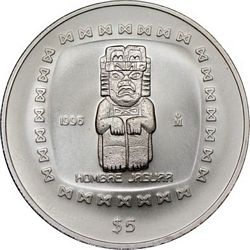
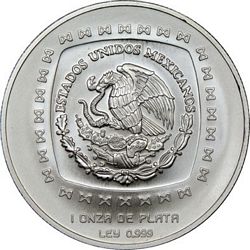
Hombre Jaguar 1996
Variety 1 (MMR)
$5 New Pesos

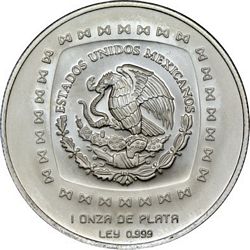
Hombre Jaguar 1998 (MMR)
$5 New Pesos

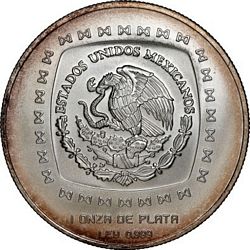
Hombre Jaguar 1998
Variety 2 (MML)
$5 New Pesos
These three coins illustrate an exceedingly nuanced divergence in original mintage statistics across all three primary sources. There is almost no congruence in numbers across sources. the Whitman Encyclopedia of Mexican Money reports 1,500 for Variety 1 (MMR), 1,500 for Variety 2 (MML), and 2,300 for 1998 (MMR). The Standard Catalog of World Coins makes one combined entry of 1,500 for all of 1996 Brilliant Uncirculated and 6,000 for 1998 (MMR). And Numista also makes one combined entry for all of 1996 Brilliant Uncirculated with a figure of 6,000 and 6,000 for 1998 (MMR).
What is rather peculiar is that both the Standard Catalog of World Coins and Numista both publish an alleged mintage of 4,800 for a 1998 Proof variety of the coin. I raise this outlier distinction in this section for a reason that I will discuss shortly. But first I would like to clarify that there is zero evidence of the existence of a 1998 Hombre Jaguar Proof (MMR). No one in the Mexican Numismatic community has been able to confirm its existence.
Some collectors have tried to point out NGC’s population report for proof finish Pre-Columbians. There is an entry for a 1998 Hombre Jaguar proof matte with a population of one. In fact, there are several other entries for these 1998 issues, two of which are also part of the Olmec collection. They are the Señor de las Limas and the Hacha Ceremonial, both also with a population of one, the latter coin design of which will be discussed later in this article. The insight I can offer on this is that there is in fact zero evidence that these are proof coins. I am actually the owner of the single Hacha Ceremonial Proof Matte. As highlighted in the image of the coin here, this is essentially a Brilliant Uncirculated coin incorrectly attributed as Proof Matte. It is hypothesized amongst collectors of Pre-Columbians that NGC was not familiar with the series and initially incorrectly designated the coins as such.
While the aforementioned 1998 proof uncertainty has been settled, unfortunately the same cannot be said about the original strike mintages for the three distinct Brilliant Uncirculated issues of the Hombre Jaguar detailed above. While I have always conceded, with minimal skepticism, in deferring to the Whitman Encyclopedia, I do have my doubts in the case of the Brilliant Uncirculated Hombre Jaguar coins. In particular, for me personally and other Pre-Columbian coin collectors, the 1996 Variety 1 (MMR) has proven difficult to find. In fact, only in 2024 did NGC finally reach a population of three for this coin, the required population in order to make a coin eligible for the Pre-Columbian coin registry. I can validate this as my coin was the third one and I put in the official request for the registry slot.
Hacha Ceremonial 1998
Variety 1 (MMR)
$5 New Pesos Brilliant Uncirculated,
incorrectly attributed as Proof Matte
While I strongly believe, anecdotally, that this coin has a perceived market perception of having a mintage of 500-1,000, I will publish Bailey’s mintage numbers for all three varieties as I cannot offer more concrete proof.
The additional strikes from the years 2000 – 2011 published on the Banco de México’s website total 2,400. And while we will use Bailey’s mintage numbers for the original mintage figures, given the detailed support for the scarcity of the 1996 Variety 1 (MMR), the 2,400 restrikes will be presumed to have been split between the 1996 Variety 2 (MML) and the 1998 (MMR). Computing the restrike allocation with this logic results in 947 restrikes for the 1996 Variety 2 (MML) and 1,453 for the 1998 (MMR).
Consolidating the original strikes with the restrike computations above reconciles to a total of 1,500 1996 Variety 1 (MMR), 2,447 1996 Variety 2 (MML), and 3,753 1998 (MMR).
Applying the Melted Factor leaves us with an estimated survival mintage of 750 – 975, 1,224 – 1,591, and 1,877 – 2,439, in respective order. A summary of these figures is shown as follows:
| 1oz Silver MS Pre-Columbian Series - Hombre Jaguar | |||||
| Original Mintage | Restrikes | Total Including Restrikes | Estimated Minimum Surviving | Estimated Maximum Surviving | |
| 1996 5 Pesos Variety 1 MMR | 1,500 | 0 | 1,500 | 750 | 975 |
| 1998 5 Pesos Variety 2 MML | 1,500 | 947 | 2,447 | 1,224 | 1,591 |
| 1998 5 Pesos MMR | 2,300 | 1,453 | 3,753 | 1,877 | 2,439 |
Hombre Jaguar – Proof Variety Overview
The Proof varieties share the same coin elements as its Brilliant Uncirculated counterpart but are further distinguished by a mirrored inner field and border area on both sides with a raised and frosted denomination on the reverse as well as a raised and frosted legend on the obverse. Only 1996 varieties were released for the proof edition of this coin design. They share the same distinction of Variety 1 MMR and Variety 2 MML.
Hombre Jaguar 1996 Variety 1 (MMR)
$5 New Pesos Proof
Hombre Jaguar 1996 Variety 2 (MML)
$5 New Pesos Proof
It is no surprise that the discrepancies in original mintage statistics across all three primary sources are present on the Proof side for Hombre Jaguar as well. The Whitman Encyclopedia of Mexican Money reports 2,800 for Variety 1 (MMR) and 1,200 for Variety 2 (MML). The Standard Catalog of World Coins makes one combined entry of 4,200 for both varieties. And Numista also makes one combined entry of 2,800.
Again we will defer to the Whitman Encyclopedia of Mexican Money for the original strike mintage. The perceived market scarcity of Variety 1 on the Brilliant Uncirculated is not present for its Proof counterpart. They are not difficult to find.
The additional strikes from the years 2000 – 2011 published on the Banco de México’s website total 1,400. Partitioning these at an equal ratio of their prevalence for the original strike results in 980 for Variety 1 (MMR) and 420 for Variety 2 (MML). With these additional strikes in subsequent years, the grand total combined is 3,780 and 1,620 respectively.
Applying the Melted Factor, discussed in the introduction, of 35-50% leaves us with an estimated survival mintage of 1,890 – 2,457 and 810 – 1,053 respectively. The figures gathered above are shown in the following table:
| 1oz Silver MS Pre-Columbian Series - Hombre Jaguar | |||||
| Original Mintage | Restrikes | Total Including Restrikes | Estimated Minimum Surviving | Estimated Maximum Surviving | |
| 1996 5 Pesos Variety 1 MMR | 2,800 | 980 | 3,780 | 1,890 | 2,457 |
| 1998 5 Pesos Variety 2 MML | 1,200 | 420 | 1,620 | 810 | 1.053 |
El Luchador
The stone sculpture known as El Luchador (The Wrestler) was found in the state of Veracruz near the Rio Uxpanapa, and is housed in the National Museum of Anthropology. The sculpture is about two feet tall and represents a seated man with his arms at shoulder height, elbows bent, hands in fists — a dynamic attitude, as if he is playing some sort of sport or fighting. The coin’s border is based on ornamental elements from a ceremonial Olmec vase.
The silver 1oz coins in this design were issued in 1996 in both Brilliant Uncirculated and Proof, in 5 pesos denomination. This coin was issued again in 1998 in Brilliant Uncirculated only.
El Luchador – Brilliant Uncirculated (BU) Variety Overview
The brilliant uncirculated coin has a reverse with a seated figure of El Luchador at the center of the field with the date to the left, the mintmark to the right (MMR), and EL LUCHADOR in the exergue below. An ornamental border surrounds the square field whose perimeter is defined with convex sides, with N$5 below. The design of the 1996 and 1998 editions is identical, only distinguished by the year. The obverse is identical to its Olmec collection counterparts, with the exception of the coin border, in which the patterns are unique to each coin in the collection.
El Luchador 1996
$5 New Pesos (MMR)
El Luchador 1998
$5 New Pesos (MMR)
There were 7,100 original strikes for the 1996 issue of the 1oz silver El Luchador coin according to both the Standard Catalog of World Coins and the Whitman Encyclopedia of Mexican Money. Numista contains an outlier mintage entry of 4,500.
For the 1998 edition of this coin, the first two references above published 2,100 and 2,000 respectively. Numista does not even contain an entry for the coin.
The additional restrikes, lacking distinction between the years for the two coins, totals 3,600. As done with earlier coins, we will distribute this total between the 1996 and 1998 varieties by applying the ratio of 1996 vs. 1998 for Bailey’s original mintage statistics. A computation with this methodology results in additional strikes in subsequent years, for the 1996 and 1998 varieties, of 2,778 and 822 respectively.
With the additional strike figures detailed above, the grand total combined per 1996 and 1998 variety is 9,878 and 2,922 respectively.
Applying the Melted Factor, discussed in the introduction, of 35-50%, leaves us with an estimated survival mintage of 4,939 – 6,421 for the 1996 variety and 1,461 – 1,900 for the 1998 variety. Collating all the aforementioned figures results in the following table:
| 1oz Silver MS Pre-Columbian Series - El Luchador | |||||
| Original Mintage | Restrikes | Total Including Restrikes | Estimated Minimum Surviving | Estimated Maximum Surviving | |
| 1996 5 Pesos MMR | 7,100 | 2,778 | 9,878 | 4,939 | 6,421 |
| 1998 5 Pesos MMR | 2.100 | 822 | 2.922 | 1,461 | 1,900 |
El Luchador – Proof Variety Overview
The 1oz El Luchador silver Proof shares the same coin elements as its Brilliant Uncirculated counterpart but is further distinguished by a mirrored inner field and border area on both sides with a raised and frosted denomination on the reverse as well as a raised and frosted legend on the obverse. Only a 1996 variety was released for the Proof edition of this coin design.
The Standard Catalog of World Coins and the Whitman Encyclopedia of Mexican Money agree on the original mintage of 3,800 for this coin. Numista unfortunately once again has published a peculiar figure of 2,700.
The additional strikes from the years 2000 – 2011 published on the Banco de México’s website amount to 1,200. With the additional strikes in subsequent years, the grand total combined is 5,000.
El Luchador 1996
$5 New Pesos (MMR) Proof
Applying the Melted Factor of 35-50%, leaves us with an estimated survival mintage of 2,500 – 3,250. The figures gathered above result in the following table:
| 1oz Silver MS Pre-Columbian Series - El Luchador | |||||
| Original Mintage | Restrikes | Total Including Restrikes | Estimated Minimum Surviving | Estimated Maximum Surviving | |
| 1996 5 Pesos MMR | 3,800 | 1,200 | 5,000 | 2,500 | 3,250 |
Hacha Ceremonial
A Mesoamerican ceremonial ax or hachet was a piece of stone, often greenstone, carved into an ax-head shape and decorated with symbolic figures. A cleft was often carved into the back and top of the head. Ceremonial axes may have been used for rituals pertaining to agriculture. The humanlike figure on which the Olmec 1 ounce Hacha Ceremonial coin is based on is from the National Museum of Anthropology. Its facial features resemble those of the Jaguar-Man. When the figure on which the design is based is viewed in profile, the body tapers at the bottom to a wedge. The coin’s border design echoes the shape of the Jaguar-Man’s eyebrows.
The silver 1oz coins in this design were issued in 1996 in both Brilliant Uncirculated and Proof, in 5 pesos denomination. This coin was issued again in 1998 in Brilliant Uncirculated only.
Hacha Ceremonial – Brilliant Uncirculated (BU) Variety Overview
The Brilliant Uncirculated coin has a reverse with a Ceremonial Ax figure at the center of the field with the date to the left, the mintmark to the right (MMR), and HACHA CEREMONIAL in the exergue below. An ornamental border surrounds the square field whose perimeter is defined with convex sides, with N$5 below. The design of the 1996 and 1998 editions is identical, only distinguished by the year. The obverse is identical to its Olmec collection counterparts, with the exception of the coin border, in which the patterns are unique to each coin in the collection.
Hacha Ceremonial 1996
$5 New Pesos (MMR)
Hacha Ceremonial 1998
$5 New Pesos (MMR)
There were 7,500 original strikes for the 1996 issue of the 1oz silver Hacha Ceremonial coin according to both the Standard Catalog of World Coins and the Whitman Encyclopedia of Mexican Money. Numista contains a mintage entry of 7,000.
For the 1998 edition of this coin, each of the aforementioned primary sources have published 2,500, 2,000, and 2,000 respectively.
The additional restrikes, lacking distinction between the years for the two coins, total 4,000. As done in earlier coins, we will distribute this total between the 1996 and 1998 varieties by applying the ratio of 1996 vs. 1998 for Bailey’s original mintage statistics. According to this methodology the resulting additional strikes in subsequent years, per 1996 and 1998 variety, were 3,000 and 1,000 respectively.
With the additional strike figures detailed above, the grand total combined per 1996 and 1998 variety is 10,500 and 3,500 respectively.
Applying the Melted Factor of 35-50% leaves us with an estimated survival mintage of 5,250 – 6,825 for the 1996 variety and 1,750 – 2,275 for the 1998 variety. Collating all the aforementioned figures results in the following table:
| 1oz Silver MS Pre-Columbian Series - Hacha Ceremonial | |||||
| Original Mintage | Restrikes | Total Including Restrikes | Estimated Minimum Surviving | Estimated Maximum Surviving | |
| 1996 5 Pesos MMR | 7,500 | 3,000 | 10,500 | 5,250 | 6,825 |
| 1998 5 Pesos MMR | 2,500 | 1,000 | 3,500 | 1.750 | 2,275 |
Hacha Ceremonial – Proof Variety Overview
Hacha Ceremonial 1996
$5 New Pesos (MMR) Proof
The 1oz Hacha Ceremonial silver Proof shares the same coin elements as its Brilliant Uncirculated counterpart but is further distinguished by a mirrored inner field and border area on both sides with a raised and frosted denomination on the reverse as well as a raised and frosted legend on the obverse. Only a 1996 variety was released for the Proof edition of this coin design.
The Standard Catalog of World Coins and the Whitman Encyclopedia of Mexican Money agree on the original mintage of 3,700 for this coin. Numista unfortunately once again has published its own figure of 3,500.
The additional strikes from the years 2000 – 2011 published on the Banco de México’s website amount to 1,000. With the additional strikes in subsequent years, the grand total combined is 4,700.
Applying the Melted Factor, discussed in the introduction, of 35-50% leaves us with an estimated survival mintage of 2,350 – 3,055. The figures gathered above result in the following table:
| 1oz Silver MS Pre-Columbian Series - Hacha Ceremonial | |||||
| Original Mintage | Restrikes | Total Including Restrikes | Estimated Minimum Surviving | Estimated Maximum Surviving | |
| 1996 5 Pesos MMR | 3,700 | 1,000 | 4,700 | 2,350 | 3,055 |
Epilogue
Readers are probably wondering why coins of this collection were minted across multiple years, specifically 1996 and 1998, without any impact from any coin reform acts. My friend Scott Doll’s remark on this is essentially “Don Bailey is probably the only person who would know with any certainty since he worked so closely with the mint on that series, but with his passing, we will not be able to get any info”. Perhaps it was decided to mint with an additional date of 1998 to help keep some interest in the waning years of the series.
Summary
This completes my fourth article on the Pre-Columbian series for 1 ounce silver coins. It was my intention to continue to provide clarity into the multiple varieties and the ambiguity surrounding mintages for this collection by curating a series of charts that will serve as a more realistic reflection of the available quantities in the market. This by no means is an authoritative guide but does address the deficiencies not addressed in some of the references cited. Two articles remain, honoring the remaining Pre-Columbian civilizations: Teotihuacan and Toltec.
To finish, I would like to recognize Felix Kirzhner for his continued recommendations on various considerations related to the ambiguities discussed in this article. I would also like to acknowledge and recognize Scott Doll whose encouragement inspired me to begin writing and continuing to write this series. His additional support on best practices for USMexNA articles and suggestions for enhancements were instrumental in organizing these articles. I would also like to thank him for sharing the coin images shown in this article. I would also like to acknowledge Doug Plasencia at Numismatic Guaranty Company (NGC) for his work on the set of NGC PhotoVision high resolution coin images used in these articles that were shared by Scott.
Please send your comments, questions, or suggestions regarding this article, to me at
References:
Bailey, Don, and Lois. Whitman Encyclopedia of Mexican Money, Volume 2: Modern Coins of Mexico, 1905 to Date. Atlanta, GA: Whitman Publishing, LLC, 2015.
Banxico.org.mx Economic Information System (SIE) Coins and Medals – CM27, Annual, Pieces, Flows.
Michael, Thomas, Tracy L. Schmidt, and Richard Giedroyc 2019 Standard Catalog of World Coins. Stevens Point, WI: Krause Publications, 2018.
Numista Mexico Pre-Columbian Mayan Coinage. https://en.numista.com/catalogue/series.php?id=1913
